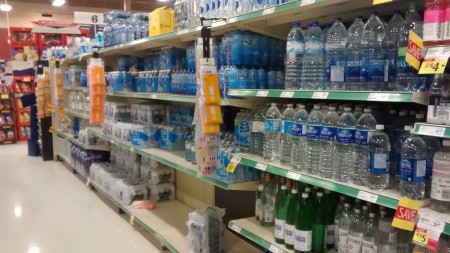In a confined space I can survive 3 days without water, but only minutes without fresh air. So which is more critically important air or water? I try to drive this concept home in many of the technical talks we do for professionals who design and construct homes. Ironically, gauging by what North Americans spend their money on, it’s clearly not fresh air, but bottled water.

You know who you are! Schlepping expensive bubbly water from Italy, maybe some still water from France – you can afford fresh air, just drink tap water!
Old habits die hard in a country where fresh clean water abounds. My goal here is to convince homeowners and professionals that they should take money earmarked for bottled water and invest it in a balanced, commissioned ventilation system for their home. Let’s clear the air a bit shall we?
What is “Fresh Air” anyhow?
“Fresh air” is defined by building scientists not by how much vital oxygen the air contains nor by how high the CO2 levels are, but rather by how fresh it “smells”. Outdoor atmospheric oxygen levels are at about 21.5% and CO2 rarely above 400ppm where IAQ guidance documents establish a recommended limit of 1000 ppm in indoors. Still, the canary in the coal mine is smell, if the air smells “off” it’s time to ventilate – In with the good, out with the bad!
What’s the proper ‘dosage’ for fresh air?
Like the rate of drinking 8 cups of water/day keeps you healthy, there’s a specific rate for ventilating a room for optimum health too. By ‘ventilation rate’ we mean bring in a specific ‘dose’ of fresh air per person per minute and ideally exhaust the same amount of stale air. As Dr. Joe Lstiburek puts it ever so succinctly in BSI-069 regarding mechanical ventilation:
- “Blowing is better than sucking” – because blowing mixes air in the room.
- “But if the only option is sucking over nothing, then suck. Sucking still sucks, but it is better than nothing. But remember you need to suck a lot and sucking a lot has its own problems.” Sucking only systems, bath exhaust fans for example, depressurise homes, sometimes to dangerous levels if combustion appliances like open-faced fireplaces and low or mid-efficiency furnaces or water heaters are in a tight house.
- “Sucking and blowing at the same time is better than blowing.” In other words, balanced ventilation systems keep the pressure in the house the same as outside of the house and ensure a specific ‘dose’ of fresh air.
- “If you then add energy recovery you are over the top.” For example HRV and ERV as opposed to relying solely on kitchen range hoods and bath fans.
How Much ‘New’ air keeps it ‘Fresh Smelling’ ?
We recently toured the Odour Lab at PINCHIN Environmental in Mississauga and they will confirm that the human nose is an incredibly sensitive instrument for detecting very small odour concentrations. So it begs the question, what’s the ventilation rate for each occupant? Turns out in a regular sized home the ‘dose’ of new air needed to keep the air fresh it’s about 10 cubic feet per minute per person. That’s a bit more than 10 basketball’s volumes worth of air for each person every minute. That translates to 30 litres per minute of new air per occupant coming into the house.
As per the good Doctor’s instructions above, the ideal system brings in and distributes fresh air while exhausting stale air from the worst rooms (bath, kitchen, laundry and hockey bag room), recovers heat and humidity.
